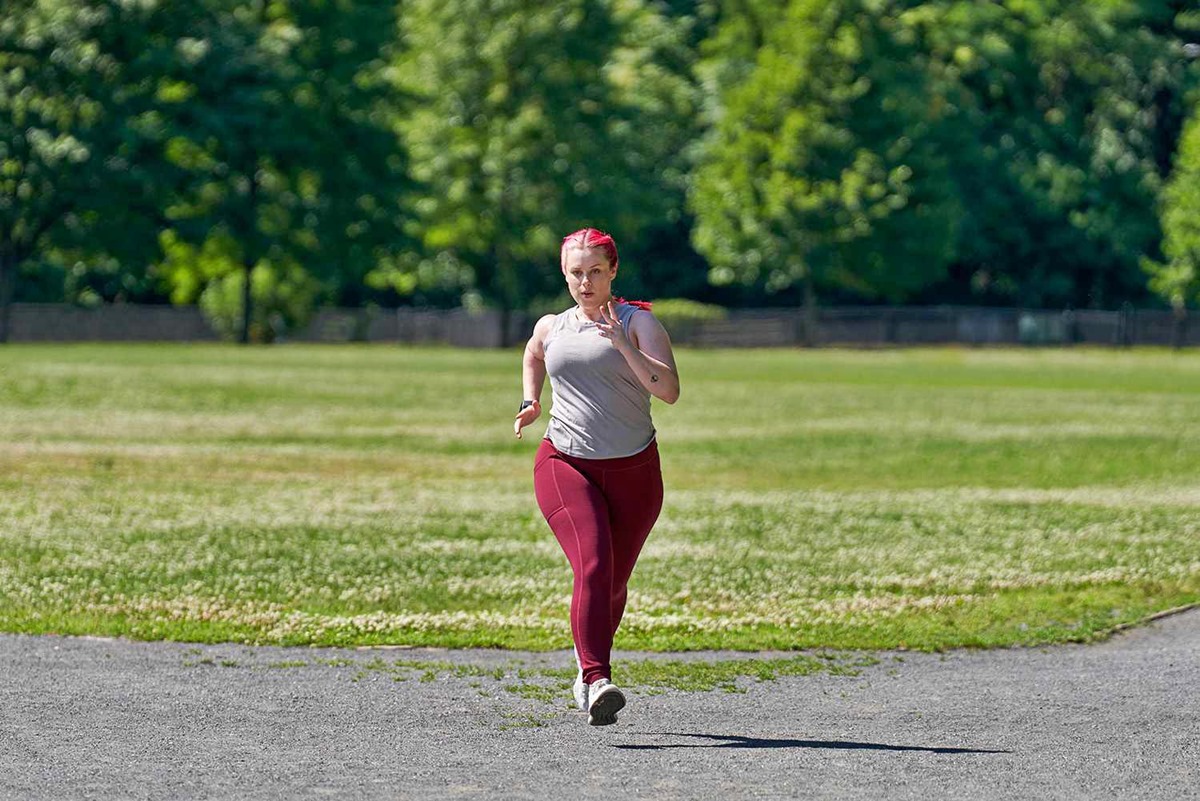

Featured
How To Increase Speed And Endurance
Modified: August 21, 2023
Learn the top tips and tricks to boost your speed and endurance with our featured guide. Enhance your performance and achieve your fitness goals faster.
Introduction
Welcome to the world of speed and endurance training! Whether you’re a seasoned athlete looking to improve your performance or a fitness enthusiast looking to take your workouts to the next level, focusing on speed and endurance will help you reach your goals.
Speed refers to the ability to move quickly and efficiently, while endurance is the capacity to sustain physical effort over an extended period. Both speed and endurance are essential components of athleticism and can greatly impact your overall fitness level, sports performance, and daily activities.
Engaging in regular speed and endurance training offers a multitude of benefits. It not only improves your cardiovascular fitness but also enhances your muscular strength, power, agility, and overall body composition. Moreover, it helps boost your metabolism, increases energy levels, and promotes a healthy lifestyle. Whether you participate in running, cycling, swimming, team sports, or any other physical activity, incorporating speed and endurance training into your routine can bring about significant improvements.
This article will provide you with valuable insights into the world of speed and endurance training. We will explore the basic principles of training, offer practical tips to improve your speed and endurance, delve into the importance of warm-up and cool-down techniques, discuss structured training programs, interval training, cross-training, nutrition and hydration, injury prevention strategies, mental strategies, and recovery methods.
It is essential to note that while speed and endurance training can benefit athletes, it is also suitable for individuals at all fitness levels. Whether you’re a beginner or an advanced exerciser, there are various training approaches and modifications that can be tailored to your specific needs and abilities.
So, get ready to embark on a journey towards enhanced speed and endurance. By incorporating these training techniques and strategies into your routine, you will take your fitness game to new heights and achieve personal milestones you never thought possible. Let’s dive in!
Importance of Speed and Endurance Training
Speed and endurance training play a vital role in improving athletic performance and overall fitness. Whether you’re a competitive athlete or a recreational exerciser, incorporating these training methods into your routine can bring about significant benefits.
One of the primary reasons speed and endurance training is important is because it helps to improve cardiovascular fitness. Engaging in activities that elevate your heart rate and challenge your cardiovascular system, such as running, cycling, or swimming, can strengthen your heart and lungs, improving their efficiency in delivering oxygen to your muscles. This increased cardiovascular fitness allows you to sustain longer periods of intense activity, improving your endurance.
Speed training, on the other hand, focuses on enhancing your ability to move quickly and efficiently. By incorporating speed drills and exercises into your routine, you can improve your running mechanics, increase stride length, and develop explosive power. This can be particularly beneficial for athletes involved in sports that require quick bursts of speed, such as sprinting, basketball, or soccer.
Besides improving cardiovascular fitness and speed, engaging in speed and endurance training can lead to several other advantages. These include:
- Improved muscular strength and power: Speed and endurance training target different muscle fibers, helping to increase overall muscular strength and power.
- Enhanced body composition: Regular training can promote fat loss and increase lean muscle mass, leading to improved body composition.
- Increased energy levels: Engaging in regular physical activity, including speed and endurance training, can boost your energy levels, making you feel more energized throughout the day.
- Boosted metabolism: Speed and endurance training can increase your metabolic rate, helping you burn more calories even at rest.
- Improved mental resilience: Endurance training can enhance mental toughness and discipline, which can be beneficial in various aspects of life.
- Reduced risk of chronic diseases: Regular exercise, including speed and endurance training, can help prevent and manage various chronic conditions such as obesity, diabetes, and cardiovascular diseases.
Regardless of your fitness level or athletic goals, incorporating speed and endurance training into your routine can positively impact your overall health and well-being. It can increase your physical capabilities, enhance your performance in sports and other physical activities, and improve your overall quality of life.
In the next sections, we will explore the basic principles of speed and endurance training and provide practical tips to help you improve your speed and endurance levels. Stay tuned!
Basic Principles of Speed and Endurance Training
Before diving into speed and endurance training, it’s important to understand the basic principles that guide these types of workouts. By following these principles, you can maximize your training effectiveness and minimize the risk of injury.
1. Progressive Overload: The principle of progressive overload is the foundation of any effective training program. This principle involves gradually increasing the intensity, duration, or volume of your training to continually challenge your muscles and cardiovascular system. By progressively overloading your body, you stimulate adaptations that lead to increased speed and endurance.
2. Specificity: The principle of specificity states that training should be specific to the desired outcome. To improve speed, you need to incorporate exercises and drills that mimic the movement patterns and intensity of your sport or activity. Likewise, to enhance endurance, you should engage in activities that require sustained effort over a prolonged period of time, such as long-distance running or cycling.
3. Rest and Recovery: Rest and recovery are essential components of any training program. Adequate rest allows your muscles and body systems to recover, repair, and adapt to the training stimulus. Make sure to include rest days in your schedule and prioritize quality sleep to optimize recovery and prevent overtraining.
4. Variation: Incorporating variety into your speed and endurance training can help prevent boredom, stimulate different muscle groups, and promote overall fitness development. Try different training methods, workout formats, and exercise variations to keep your routine fresh and challenging.
5. Warm-up and Cool-down: Proper warm-up and cool-down routines are crucial for preparing your body for exercise and aiding in recovery. A dynamic warm-up, consisting of dynamic stretches and movements, increases blood flow to the muscles and joints, improving flexibility and reducing the risk of injury. Similarly, a cool-down routine, including static stretching and light aerobic activity, helps reduce muscle soreness and promotes recovery.
6. Listen to Your Body: Pay attention to your body’s signals and adjust your training accordingly. Push yourself when you’re feeling strong, but also know when to scale back or take a rest day if you’re experiencing pain or fatigue. It’s important to find the right balance between pushing your limits and preventing injury.
Remember, these principles should guide your training, but they can be applied and adapted based on your individual goals, fitness level, and preferences. Taking a holistic approach and focusing on proper technique, nutrition, and recovery will ensure that you derive the maximum benefits from your speed and endurance training.
In the next section, we will provide practical tips to help you improve your speed and endurance levels. Stay tuned!
Tips to Improve Speed and Endurance
If you’re looking to improve your speed and endurance, incorporating these tips into your training routine can help you achieve your goals:
- Incorporate High-Intensity Interval Training (HIIT): HIIT is a training method where you alternate between periods of high-intensity exercise and active recovery. This type of training helps improve both speed and endurance by challenging your cardiovascular system and pushing your limits. Mix in HIIT sessions, such as sprint intervals or Tabata workouts, to boost your fitness levels.
- Include Long Slow Distance (LSD) Runs: LSD runs are longer, slower-paced distance runs that help develop endurance. By running at a comfortable pace for an extended period of time, you train your body to sustain activity for longer durations. Aim for one or two LSD runs per week, gradually increasing the distance over time.
- Focus on Tempo Runs: Tempo runs involve running at a comfortably hard pace, just below your maximum effort. These runs improve your lactate threshold, the point at which lactic acid builds up in your muscles. By pushing this threshold higher, you can sustain a faster pace for longer periods. Incorporate tempo runs into your training once or twice a week.
- Strengthen Your Core and Lower Body: A strong core and lower body are crucial for speed and endurance activities. Incorporate exercises such as planks, squats, lunges, and calf raises to build strength and stability in these areas. Strong muscles will help you maintain proper form, prevent injuries, and generate more power during your workouts.
- Include Plyometric Exercises: Plyometric exercises, also known as “jump training,” help improve explosive power and speed. Incorporate exercises like box jumps, squat jumps, and burpees into your routine to enhance your ability to generate force and move quickly.
- Don’t Neglect Cross-Training: Engaging in activities other than your primary sport or exercise can enhance overall fitness and prevent overuse injuries. Incorporate cross-training activities like swimming, cycling, or strength training to work different muscle groups and improve your overall fitness level.
- Gradually Increase Training Volume: To improve both speed and endurance, it’s important to gradually increase your training volume over time. Avoid sudden increases in distance, intensity, or frequency, as this can increase the risk of injury or burnout. Instead, make incremental increases in your training load to allow your body to adapt and progress safely.
- Stay Consistent and Be Patient: Improving speed and endurance takes time and consistency. Stick to your training plan, be patient, and trust the process. Results may not come overnight, but with consistent effort, you will see improvements in your speed and endurance over time.
Remember to listen to your body and make adjustments to your training plan as needed. Rest and recovery are just as important as training, so make sure to include rest days in your schedule and prioritize quality sleep.
By incorporating these tips into your training regimen, you’ll be well on your way to improving your speed and endurance, and reaching new heights in your athletic performance.
Proper Warm-up and Cool-down Techniques
Proper warm-up and cool-down techniques are essential components of any speed and endurance training routine. They help prepare your body for exercise, reduce the risk of injury, and aid in recovery. Here are some key points to consider when it comes to warming up and cooling down:
Warm-up:
A warm-up is a crucial part of your training session as it prepares your body both physically and mentally for the upcoming activity. Here are some important components of an effective warm-up:
- Dynamic Stretching: Start with dynamic stretching exercises that focus on loosening up major muscle groups and increasing joint mobility. Dynamic stretches should involve controlled movements that mimic the activity you’ll be performing, gradually increasing in intensity as you go.
- Cardiovascular Activity: Incorporate light aerobic exercises such as jogging, cycling, or jumping jacks to increase blood flow and raise your heart rate. This helps warm up your muscles and prepares your cardiovascular system for the upcoming workout.
- Specific Movement Preparation: Perform movements or exercises specific to the activity you’ll be engaging in. For example, if you’re a runner, include some short strides or skipping drills. If you’re a cyclist, warm up on a stationary bike or with gentle cycling on the road.
- Mental Preparation: Use your warm-up time to mentally focus and prepare for your training session. Visualize the movements and goals of your workout, and set a positive mindset to enhance performance.
A well-designed warm-up should be progressive, starting with low-intensity activities and gradually increasing in intensity. It should last around 10-15 minutes, ensuring that your body is adequately warmed up and ready to tackle the main workout.
Cool-down:
After completing your main workout, it’s equally important to cool down and allow your body to gradually return to its pre-exercise state. Here are some key components of an effective cool-down:
- Gradual Reduction of Intensity: Slowly reduce the intensity of your exercise. For example, if you finished a run, gradually reduce your pace to a brisk walk before coming to a complete stop.
- Static Stretching: Include static stretches, focusing on major muscle groups, to improve flexibility and alleviate any muscle tightness or tension. Hold each stretch for 15-30 seconds without bouncing, and breathe deeply to promote relaxation.
- Hydration and Refueling: During your cool-down, rehydrate and refuel your body by drinking water and consuming a post-workout snack or meal containing carbohydrates and protein. This aids in muscle recovery and replenishes energy stores.
- Mindful Reflection: Take a few moments to reflect on your workout and acknowledge your efforts. This can help you appreciate your progress and set intentions for future training sessions.
A proper cool-down should last around 5-10 minutes, allowing your heart rate and breathing to gradually return to resting levels. It promotes muscle recovery, reduces post-exercise muscle soreness, and prepares your body for future workouts.
Remember, warming up and cooling down are crucial parts of your training routine and should not be neglected. They are key to optimizing performance, minimizing the risk of injury, and promoting overall recovery.
Structured Training Programs for Speed and Endurance
A structured training program is essential for effectively improving speed and endurance. It provides a systematic approach to your workouts, ensuring that you progress in a safe and efficient manner. Here are some key components to consider when designing a structured training program:
Set Measurable Goals:
Start by setting specific and measurable goals for your speed and endurance training. Whether it’s improving your 5K race time, completing a half-marathon, or simply increasing your overall speed, having clear goals will help guide your training program and keep you motivated throughout the process.
Periodization:
Periodization involves dividing your training program into specific blocks or phases, each with a different focus. This allows for proper progression, avoids overtraining, and maximizes your performance potential. Common phases include the base phase (building endurance), the strength and speed phase (improving power and speed), and the taper phase (reducing training volume to peak for an event).
Variety and Progression:
Include a combination of different workouts and training methods to prevent plateauing and keep your workouts engaging. This can include interval training, tempo runs, long slow distance runs, hill repeats, and cross-training activities. Gradually increase the intensity, duration, or volume of your workouts as you progress to continually challenge your body and improve your speed and endurance levels.
Frequency and Consistency:
Consistency is key when it comes to improving speed and endurance. Aim to engage in regular workouts, ideally three to five times per week, to provide your body with consistent training stimuli. This frequency helps build endurance and allows for proper recovery between sessions.
List of Equipment:
- Heart rate monitor or fitness tracker to monitor and track your heart rate and workout intensity.
- Running shoes appropriate for your foot type and running style.
- Appropriate exercise clothing for comfort and ease of movement.
- A stopwatch or a timing device for interval training.
- Stretching bands or foam roller for active recovery and flexibility exercises.
Rest and Recovery:
Remember to incorporate rest days into your training program to allow your body to recover and adapt. Rest is when your body repairs and strengthens muscles, allowing you to perform at your best. Additionally, prioritize sleep to optimize recovery and ensure you’re getting enough restorative rest each night.
A well-structured training program takes into account your current fitness level, your goals, and the timeframe you have to achieve them. It is essential to listen to your body, make adjustments as needed, and seek guidance from a certified coach or trainer if necessary.
By following a structured training program, you’ll be able to track your progress, stay motivated, and see noticeable improvements in your speed and endurance over time.
Interval Training: A Key Component for Speed and Endurance
Interval training is a highly effective method for improving both speed and endurance. It involves alternating periods of high-intensity exercise with periods of active recovery or lower-intensity exercise. This type of training challenges your cardiovascular system, improves your aerobic and anaerobic capacity, and boosts your overall athletic performance. Here’s why interval training is a key component for improving speed and endurance:
Increased VO2 Max:
Interval training helps improve your VO2 max, which is the maximum amount of oxygen your body can utilize during intense exercise. By challenging your cardiovascular system with short bursts of high-intensity exercise, followed by recovery periods, your body adapts by increasing its ability to take in and utilize oxygen. This leads to improved endurance and the ability to sustain a higher work rate for longer periods.
Elevated Anaerobic Threshold:
Interval training raises your anaerobic threshold, which is the point at which lactic acid starts to build up in your muscles. By pushing your body to work at higher intensity levels, you teach it to tolerate and clear lactic acid more efficiently. This allows you to maintain a faster pace or higher intensity for longer durations, delaying the onset of fatigue.
Improved Speed:
Interval training is particularly effective for improving speed. By incorporating high-intensity intervals, such as sprints or fast-paced intervals, you train your body to move at a faster pace. These short bursts of intense effort help improve your running mechanics, increase stride length, and enhance neuromuscular coordination. Over time, this leads to improved speed and the ability to maintain a quicker pace during races or workouts.
Time Efficiency:
Interval training allows you to achieve significant fitness gains in a shorter amount of time compared to traditional steady-state cardio workouts. By incorporating shorter, intense bursts of exercise, you can reap the benefits of a longer workout in a fraction of the time. This makes interval training a great option for individuals with busy schedules who still want to improve their speed and endurance.
Variety and Mental Engagement:
Interval training provides variety and mental stimulation to your workouts. The constantly changing intensity levels and intervals keep your mind engaged and prevent boredom. This helps to maintain motivation and enjoyment in your training sessions, making it easier to stick to your program and achieve your goals.
Example Interval Training Protocol:
A popular interval training protocol is the Tabata method. It involves 20 seconds of all-out effort, followed by 10 seconds of complete rest. This is repeated for a total of 8 rounds, resulting in a 4-minute high-intensity workout. Tabata training can be done with various exercises, such as running, cycling, rowing, or bodyweight exercises like burpees or jumping jacks.
It’s important to note that interval training should be tailored to your fitness level and goals. Beginners can start with longer recovery periods and shorter intense intervals, gradually progressing as their fitness improves. It’s always advisable to consult with a fitness professional to design an interval training program that suits your needs.
By incorporating interval training into your regular routine, you’ll experience significant improvements in both speed and endurance. This highly effective training method is a key component in achieving your athletic goals and taking your performance to the next level.
Cross-training for Speed and Endurance
Cross-training is a valuable strategy for improving both speed and endurance. It involves engaging in different types of physical activities or exercises that complement your primary sport or training routine. Incorporating cross-training into your workouts offers numerous benefits and can take your performance to new heights. Here’s why cross-training is important for enhancing speed and endurance:
Reduced Risk of Overuse Injuries:
Cross-training allows you to engage in different activities that work different muscle groups and movements. This reduces the risk of overuse injuries that can result from repetitive movements associated with your primary sport. By incorporating activities such as swimming, cycling, strength training, or yoga, you can provide your body with a well-rounded workout while giving specific muscles and joints a break.
Enhanced Overall Fitness:
Cross-training helps improve your overall fitness by challenging different muscle groups and energy systems. By engaging in varied activities, you can improve your cardiovascular endurance, build strength, enhance flexibility, and improve your agility. This improved overall fitness transfers to your primary sport or activity, leading to increased speed and endurance.
Addressing Weak Areas:
Cross-training allows you to focus on weaker areas or imbalances in your body. If you notice specific muscle weaknesses or limitations in your range of motion, incorporating exercises that target those areas can help improve overall performance. For example, if your lower body strength is limiting your running speed, adding strength training exercises like squats and lunges can help strengthen those muscles and improve your running speed.
Mental Refreshment:
Cross-training can provide a mental break from your primary sport or training routine. Engaging in different activities can help prevent boredom and keep your motivation levels high. Trying new exercises and exploring different physical activities can renew your enthusiasm for training, making it easier to stick to your program and achieve your goals.
Example Cross-training Activities:
There are numerous cross-training activities you can incorporate into your routine, depending on your interests, fitness level, and access to equipment. Here are some examples:
- Swimming: Swimming is a low-impact, full-body workout that improves cardiovascular fitness, muscular endurance, and flexibility.
- Cycling: Cycling is an excellent cardiovascular exercise that builds leg strength, improves endurance, and can be done indoors or outdoors.
- Strength Training: Incorporating strength training exercises like weightlifting or resistance training helps build muscle strength, power, and overall body stability.
- Yoga/Pilates: These activities improve flexibility, core strength, balance, and body awareness, which can enhance performance and prevent injuries.
- Interval Training: High-intensity interval training (HIIT) sessions can be incorporated into your cross-training routine to improve both speed and endurance.
- Team Sports: Playing team sports like basketball, soccer, or tennis can improve agility, coordination, and overall fitness.
When incorporating cross-training into your routine, the key is to choose activities that complement your primary sport or training goals. Aim for two to three cross-training sessions per week, and ensure that you give adequate time for recovery and adaptation.
By incorporating cross-training into your overall training plan, you’ll enjoy the benefits of improved overall fitness, reduced risk of injuries, and increased speed and endurance. So, get out there and explore different types of activities to take your athletic performance to the next level!
Nutrition and Hydration for Improved Speed and Endurance
Proper nutrition and hydration are fundamental for enhancing speed and endurance. Fueling your body with the right nutrients and maintaining adequate hydration levels can significantly impact your athletic performance and support optimal recovery. Here are some essential guidelines for nutrition and hydration:
Pre-Exercise Nutrition:
Before a speed or endurance training session, focus on consuming a balanced meal that includes a combination of carbohydrates, protein, and healthy fats. Carbohydrates provide the necessary fuel for energy, while protein helps with muscle repair and recovery. Opt for easily digestible foods, such as whole grains, fruits, lean proteins, and small amounts of healthy fats. Give yourself enough time to digest the meal, ideally eating 2-3 hours before your training session to avoid discomfort.
During Exercise Nutrition:
For longer duration workouts or races exceeding 60 minutes, consider consuming carbohydrates to maintain energy levels. Sports drinks, energy gels, or easily digestible snacks, like energy bars or fruit, can be beneficial during extended exercise sessions. Aim to consume around 30-60 grams of carbohydrates per hour, depending on the intensity and duration of your workout. Experiment with different forms of fueling to find what works best for you and doesn’t cause any digestive distress.
Hydration:
Proper hydration is crucial for optimal performance. Dehydration can lead to decreased performance, fatigue, and increased risk of injury. Hydration needs vary depending on factors such as body weight, sweat rate, and environmental conditions. Aim to drink water regularly throughout the day and ensure you’re adequately hydrated before beginning your training session. During exercise, listen to your body’s thirst cues and sip water consistently. For longer workouts, consider including electrolyte-rich sports drinks to replace lost fluids and minerals.
Post-Exercise Nutrition:
After your training session, prioritize post-workout nutrition to facilitate recovery and replenish glycogen stores. Consume a meal or snack containing protein and carbohydrates within 30-60 minutes of completing your workout. This can be in the form of a combination of lean protein, whole grains, fruits, and vegetables. Adequate post-exercise nutrition promotes muscle repair, glycogen replenishment, and overall recovery.
Optimizing Macronutrients:
While carbohydrates are crucial for fueling intense exercise and supporting endurance, it’s also important to include lean proteins and healthy fats in your diet. Protein aids in muscle repair and recovery, while healthy fats provide essential nutrients and promote satiety. Strive for a well-balanced diet that includes lean sources of protein such as chicken, fish, tofu, or legumes, along with healthy fats from sources like avocados, nuts, and seeds.
Individualized Approach:
Everyone’s nutritional needs can vary, so it’s important to find what works best for you through trial and error. Consider working with a registered dietitian or sports nutritionist who can provide personalized guidance based on your specific goals, training, and dietary preferences. They can help you optimize your nutrition to support speed, endurance, and overall athletic performance.
Remember, proper nutrition and hydration are vital for improved speed and endurance. By fueling your body with the right nutrients and maintaining adequate hydration levels, you’ll optimize your performance, enhance recovery, and reach your athletic goals more effectively.
Injury Prevention Strategies for Speed and Endurance Athletes
When it comes to speed and endurance training, injury prevention is crucial. The repetitive nature of these activities and the high demands placed on the body can increase the risk of injuries. However, by incorporating injury prevention strategies into your training routine, you can minimize the chances of getting sidelined. Here are some key strategies to help prevent injuries:
Proper Warm-up and Cool-down:
Begin each training session with a dynamic warm-up to increase blood flow, warm up your muscles, and improve flexibility. Incorporate exercises that target the specific muscles and movements used in your activity. Similarly, cool down after each session with light aerobic activity and static stretching to promote muscle recovery and reduce post-exercise muscle soreness.
Gradual Progression and Rest Days:
Avoid the temptation to increase mileage or intensity too rapidly. Gradually increase your training volume to allow your body to adapt. Include rest days in your schedule to provide your muscles, tendons, and joints with time to recover and repair. Overtraining and pushing yourself too hard without proper rest can increase the risk of overuse injuries.
Strength and Conditioning:
Incorporate strength and conditioning exercises into your training routine to improve muscular strength, stability, and balance. Strong muscles can better withstand the demands of speed and endurance activities and reduce the risk of injuries. Focus on exercises that target the muscles and movements needed for your specific sport, such as squats, lunges, planks, and resisted exercises for the upper body.
Proper Technique and Form:
Ensure that you have proper running or movement technique to reduce stress on your joints and minimize the risk of injury. Maintain good posture, engage your core, and land softly with your footstrikes. Seek guidance from a coach, trainer, or physical therapist who can assess your form and offer recommendations for improvement.
Flexibility and Mobility Training:
Incorporate regular flexibility and mobility exercises to improve range of motion and prevent muscle imbalances. Target areas such as the hips, hamstrings, calves, and shoulders, as tightness or restrictions in these areas can increase the risk of injury. Use foam rollers, resistance bands, or incorporate activities like yoga or Pilates to enhance flexibility and mobility.
Listen to Your Body:
Pay attention to any signs of pain, discomfort, or unusual fatigue during your training sessions. Pushing through pain can lead to further injury. If you experience persistent or worsening symptoms, seek advice from a healthcare professional to address the issue before it escalates.
Appropriate Footwear and Equipment:
Invest in proper footwear that provides adequate support and cushioning for your specific activity. Ill-fitting or worn-out shoes can contribute to injuries. Additionally, ensure your equipment, such as bikes or other gear, is in good working condition and properly adjusted to fit your body and biomechanics.
Nutrition and Hydration:
Proper nutrition and hydration play a crucial role in injury prevention. Fuel your body with a well-balanced diet to provide the necessary nutrients for muscle repair and recovery. Stay hydrated before, during, and after your workouts to optimize performance and prevent fatigue-related injuries.
Professional Guidance:
If you’re new to speed and endurance training or have a history of injuries, consider seeking guidance from a coach, trainer, or physical therapist who specializes in your specific sport or activity. They can provide guidance on proper training techniques, help identify any biomechanical issues, and design a tailored program to reduce the risk of injuries.
By incorporating these injury prevention strategies into your training routine, you can minimize the risk of injury and keep performing at your best. Remember, prevention is key, so prioritize your long-term health and wellness as you work towards your speed and endurance goals.
Mental Strategies to Enhance Speed and Endurance Performance
When it comes to speed and endurance training, having strong mental strategies is just as important as physical preparation. The mind plays a significant role in pushing through challenging workouts, maintaining focus, and achieving peak performance. Here are some mental strategies to enhance your speed and endurance performance:
Goal Setting:
Set clear and achievable goals to provide direction and motivation for your training. Whether it’s improving your race time, increasing your running distance, or conquering a challenging hill, having specific goals helps you stay focused and committed to your training regimen. Break down big goals into smaller, manageable milestones to track your progress and boost your confidence along the way.
Positive Self-Talk:
Cultivate a positive mindset by using positive self-talk. Replace negative thoughts or doubts with encouraging and empowering statements. Remind yourself of your strengths, past successes, and the progress you’ve made. Repeat affirmations or mantras that resonate with you, such as “I am strong and capable” or “I can do this.” Positive self-talk helps build confidence, enhance motivation, and combat negative emotions during challenging moments.
Visualization:
Use visualization techniques to mentally rehearse your speed and endurance activities. Close your eyes and vividly imagine yourself performing at your best – running smoothly, maintaining a strong pace, and crossing the finish line with a sense of accomplishment. Picture the details of your environment, the sensations in your body, and the emotions you’ll feel. Visualization helps improve focus, build confidence, and create a mental blueprint for success.
Mindfulness and Present Moment Awareness:
Practice mindfulness to stay present and fully engaged during your training sessions. Focus on the sensations in your body, your breath, and the present moment rather than getting lost in thoughts about the future or past. Being mindful helps you tune into your body’s signals, maintain proper form, and make real-time adjustments for optimal performance.
Break it Down:
When facing a particularly challenging workout or race, break it down into smaller segments or intervals. Instead of overwhelming yourself with the full distance or duration, focus on one step, one minute, or one interval at a time. By breaking it down, you can stay mentally focused, maintain a consistent rhythm, and avoid feeling overwhelmed or fatigued.
Find Your Mantra:
Develop a personal mantra or phrase that resonates with you and helps you stay motivated and focused during your workouts. This could be a simple word or phrase that reminds you of your commitment, strength, or determination. Repeat your mantra silently or out loud during difficult moments to push through mental and physical barriers.
Embrace Discomfort and Embrace Challenge:
Speed and endurance training often come with discomfort and physical challenges. Rather than trying to avoid or suppress these feelings, embrace them as opportunities for growth and improvement. Shift your mindset to view discomfort as a sign of pushing your limits and getting stronger. Embrace the challenges, knowing that each one brings you closer to your goals.
Review and Reflect:
Take the time to review and reflect on your training sessions and races. Celebrate your successes, analyze areas for improvement, and learn from any setbacks or obstacles. This self-reflection enhances self-awareness and allows you to make adjustments and refine your mental strategies for future performances.
Remember, mental strategies are just as important as physical training when it comes to enhancing speed and endurance performance. Incorporate these strategies into your training routine to build mental resilience, stay motivated, and achieve your speed and endurance goals.
Recovery Methods for Speed and Endurance Training
Recovery is a crucial aspect of speed and endurance training. Giving your body time to rest and recover is essential for optimal performance and injury prevention. Implementing effective recovery methods will help you bounce back faster, reduce muscle soreness, and enhance your overall training outcomes. Here are some key recovery methods to incorporate into your speed and endurance training routine:
Rest and Sleep:
First and foremost, prioritize rest and sleep in your training regimen. Allow your body sufficient time to recover between workouts by scheduling regular rest days. Rest is when your muscles rebuild and adapt to the training stress. Aim for 7-9 hours of quality sleep each night to support recovery, as this is when important physiological processes occur, such as hormone regulation and tissue repair.
Proper Nutrition:
Ensure you’re fueling your body with proper nutrition to support recovery. After intense workouts, replenish glycogen stores by consuming carbohydrates within 30-60 minutes. Pair carbohydrates with quality protein to assist in muscle repair and growth. Include a variety of fruits, vegetables, lean proteins, whole grains, and healthy fats in your diet to provide essential nutrients for recovery.
Active Recovery:
Maintain an active recovery routine to facilitate blood flow, reduce muscle stiffness, and promote faster recovery. Engage in low-intensity activities such as light jogging, swimming, cycling, or yoga. The gentle movements help flush out metabolic waste and deliver oxygen-rich blood to the muscles, aiding in the recovery process.
Stretching and Foam Rolling:
Incorporate stretching exercises and foam rolling into your recovery routine. Static stretching can help lengthen muscles and improve flexibility, reducing the risk of injury. Foam rolling, or self-myofascial release, helps relieve muscle tension, improve circulation, and break up knots or adhesions in the muscles. Target areas prone to tightness or soreness, such as the calves, quads, hamstrings, and glutes.
Cross-Training:
Engage in different forms of physical activity or cross-training to allow your primary muscles used in speed and endurance training to recover while still keeping active. This can include activities like swimming, cycling, yoga, or strength training. Cross-training helps work different muscle groups, promotes overall fitness, and gives your body a break from repetitive movements.
Hydration:
Stay hydrated before, during, and after your workouts to support recovery. Proper hydration is essential for optimal muscle function, nutrient transportation, and overall bodily functions. Ensure you’re drinking enough water throughout the day and consider incorporating electrolyte-rich fluids for replenishing lost minerals during intense or prolonged exercise.
Massage or Deep Tissue Therapy:
Consider incorporating regular massages or deep tissue therapy into your recovery routine. These techniques can help alleviate muscle tension, improve circulation, and reduce muscle soreness. Consult with a licensed sports massage therapist or utilize self-massage tools such as foam rollers or massage balls to target specific areas.
Listening to Your Body:
Acknowledge and respect the signals your body sends you. If you feel excessively fatigued, experience pain that doesn’t go away, or notice a decline in performance, it may be a sign that you need more recovery time. Prioritize self-care, adjust your training schedule if necessary, and seek professional advice if symptoms persist.
Recovery is an integral part of speed and endurance training. By implementing these recovery methods into your routine, you’ll optimize your performance, reduce the risk of injury, and ensure long-term progress towards your speed and endurance goals.
Conclusion
Speed and endurance training are key components in improving athletic performance and overall fitness. Incorporating the essential principles of training, such as progressive overload, specificity, and proper rest and recovery, is crucial for achieving optimal results. By implementing various strategies, like interval training, cross-training, and focusing on nutrition and hydration, you can enhance your speed and endurance levels.
Proper warm-up and cool-down techniques prepare your body for exercise, prevent injuries, and aid in recovery. Structured training programs provide a systematic approach to your workouts, allowing for gradual progression and avoiding overtraining. Injury prevention strategies, such as strength and conditioning, maintaining proper form, and listening to your body, help reduce the risk of injuries commonly associated with speed and endurance training.
Enhancing your mental game is equally important. Incorporating mental strategies like goal setting, positive self-talk, visualization, and mindfulness can help you stay motivated, focused, and push through challenging moments. Recovery methods, including rest, nutrition, active recovery, and appropriate hydration, are essential for preventing burnout, reducing muscle soreness, and optimizing performance.
In conclusion, by implementing these strategies and principles into your speed and endurance training, you can reach new levels of performance. Remember, progress takes time, consistency, and dedication. Whether you’re a competitive athlete or a recreational enthusiast, embracing the journey and enjoying the process will lead to long-term success and a healthier, more fulfilling lifestyle.









